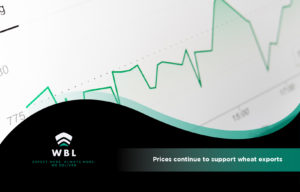Prices continue to support wheat exports
Despite climatic setbacks and production difficulties, international prices support wheat exports. Rains are needed to mitigate the loss of potential yield. Investment funds strong selling in Chicago.
According to preliminary shipment data, 0.53 Mil MT of wheat was exported in August, being the highest recorded volume for this month since the 2017/18 season. However, the Niña year was felt in production and consequently in the exports of the current 2020/21 season, and the accumulated exported quantities of the cereal so far show a drop of 22.7% compared to the previous season.
However, the improvement in prices that we’ve seen in 2021 provides support to the export values. Grain exports, which represented more than 92% of the total exported by the wheat complex in the 2019/20 campaign, show a rise of more than 28% for July 2021 compared to the same month of the previous year. Thus, the average FOB price went from 210 USD/MT to around 270 USD/MT in one year.
The rise in the average export value, however, is not enough to offset the drop in export volumes. This way, the Wheat Complex accumulates in the nine months of the 2020/21 campaign a decrease of 3.5% in its exports, compared to the same period last season.
For its part, wheat flour showed a 12.5% reduction in its exported volumes up to July of this year. Meanwhile, prices increased less than 2% year-on-year, which leaves a drop of the order of 11.6% in the value of exports. Furthermore, the rest of the wheat by-products carry exports of almost 0.18 Mil MT, a decrease of almost 27% compared to the same period last year. However, exports in dollars remain stable at around USD 86 million until July of this year, because of an average price increase of 77% year-on-year for the different wheat by-products, excluding flour.
As for export destinations, the drop in shipments to more distant regions once again underpins Brazil’s participation as a the main destination for Argentine wheat. In this sense, our neighbor and historical trading partner has bought 46% of the projected wheat exports, with shipments for more than 4 Mil MT so far this season. This number far exceeds Brazil’s share for this same time last year, when it had bought 37% of the wheat exported. At the same time, this level exceeds the average of the last 5 campaigns, of the order of 40%.
In addition, we shouldn’t forget that so far 22% of exported wheat is registered with statistical secrecy, a number higher than 14% of last year. As relevant destinations, Chile gains importance, with a market share of 9%, compared to the 2% bought last season. In turn, Indonesia loses its share, which went from buying 2.6 Mil MT to 0.4 Mil MT of wheat, or from 23% to 5% of exports.

While waiting to see if La Niña persists, is the weather still dry?
As GEA pointed out in its last report, the expectation of reaching a record yield already seems distant for wheat. With a large part of the plots in the core zone with regular to scarce water reserves, the hope is that the rainfall for the week will be able to limit the drop in potential yields. In fact, according to the information provided by the CCA group of meteorologists, as of Wednesday afternoon “the advance of a rain front from the interior of Buenos Aires province towards the central provinces has been very productive, especially in the central south of Entre Ríos province and less widely in south-central Santa Fe province. Much of the northeast of Buenos Aires province, south of Entre Ríos, corridors of the center and south of Santa Fe, and even some areas of eastern Cordoba province managed to accumulate rains with a minimum of thirty millimeters, an acceptable amount considering the increase in water demand that we’ve seen recently. ”
It remains to be seen what balance will be left by this phenomenon that began at the end of the week after the optimistic water outlook available in autumn had been left far behind. Early sowing, at the end of May, had a more complicated context than wheat sowing at the end of June. Among the former, the deficit of the wheat nucleus in the south of Buenos Aires province, while the province of Córdoba stood out.
However, the high and still growing probability of repeating a Niña year could raise these forecasts in the coming months. As already mentioned, there’s expectation for rains that have already started in some productive areas, and which would bring relief to the water deficit of the wheat fields.
Source: https://bcr.com.ar/
For more info visit
https://www.linkedin.com/company/wbl-shipping-agency/
